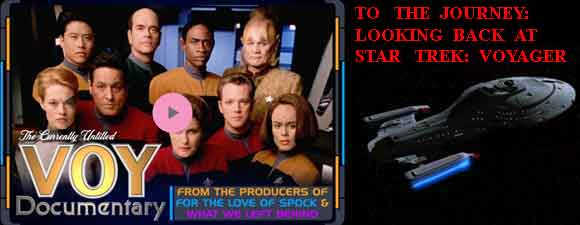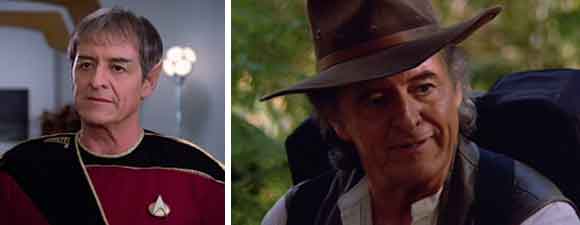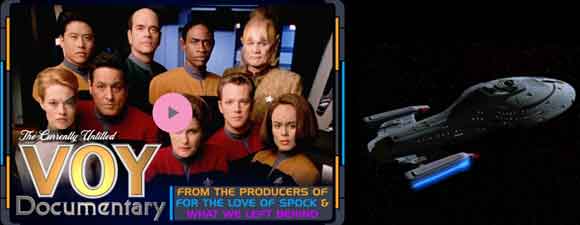Retro Review: Initiations
8 min read
Initiations
Chakotay saves a young Kazon performing a rite of passage and is imprisoned for trespassing in Kazon space.
Plot Summary: Alone on a shuttlecraft to perform a ritual to honor his late father, Chakotay is attacked by a young Kazon named Kar, who must kill an enemy to earn his Kazon-Ogla name. Forced to defend himself, Chakotay fires at Kar’s ship, then rescues the young man when that ship explodes. A Kazon raider then captures Chakotay’s shuttlecraft. The First Maje, Razik, tells Kar that he will die without a name since he failed to kill his enemy and informs Chakotay that if the Federation officer will execute Kar publicly, he will be free to go. After insisting that he is not their enemy and wants no bloodshed, Chakotay accepts the weapon, then uses it to escape, taking Kar with him. The Kazon shoot at Chakotay’s shuttlecraft, which disintegrates just as he beams himself and Kar to the surface of a moon the Kazon use to train young soldiers. Kar leads Chakotay to safely in a cave, though he explains that unless he kills Chakotay, he can never have a home among the Kazon. Chakotay sets up a homing signal so that Voyager can find them. Meanwhile, Janeway’s crew finds first the remains of Kar’s ship, then debris from the shuttlecraft, but Neelix demonstrates his knowledge of Kazon culture by forcing Razik to admit that Chakotay may be stranded on the nearby moon. Blaming himself for the fact that Kar has become an exile, Chakotay is prepared to allow the young Kazon to shoot him in full view of Razik, expecting that Voyager’s Doctor will be able to revive him. But when Janeway and Razik arrive nearly simultaneously at the cave, Kar announces that Chakotay is not his enemy and shoots Razik instead. Kar then pledges himself to the new First Maje, Haliz, promising his support. Haliz grants Kar his name and allows the Starfleet officers to leave after Kar warns that if Chakotay ever trespasses on their space again, Kar will kill him. On Voyager, Chakotay completes death ritual, asking his father to watch over himself and Kar.
Analysis: Remember how I said back at “Caretaker” that I have a complicated relationship with Voyager? This retro review will reflect that. I still have my notes from the first time I saw “Initiations,” so I can see that the first line of commentary I wrote was, “Klingons! Why did it have to be Klingons?” It may be a little anachronistic to quote Indiana Jones, and the Kazon aren’t precisely Klingons, but they’re much too close for me to find them anything other than irritating, particularly given that this episode first appeared while Deep Space Nine was on the air giving us Klingons on a regular basis. Come on, writers: Voyager ends up in the Delta Quadrant and the first dominant species they encounter is yet another honor-bound patriarchal warrior culture? If the overt message of Star Trek is supposed to be Infinite Diversity in Infinite Combinations, the more subtle message of the second-generation shows is that to get anywhere in this galaxy, you’d better belong to a clan of war-loving men who start training you young to glorify martial arts. Given the number of macho bozos they must have assimilated, it’s a wonder that the Borg have a Queen and strong women like Seven of Nine. Or maybe the Borg have learned the lesson that when you love war and obsess about your personal pride, you always end up as dead as Gowron, Dukat, Razik, et al. So you’ll have to forgive me if I can’t work up any enthusiasm for this derivative, clumsily written coming-of-age story, particularly when I’m distracted by a young Kazon who sounds exactly like Nog, whose only changes in inflection appear to be a result of Aron Eisenberg being spared having to wear Ferengi teeth. And as much as I love Vasquez Rocks as a natural wonder and a tourist spot, anyone could be excused for wondering how Chakotay went all the way to the Delta Quadrant but wound up in precisely the spot where Captain Kirk fought the Gorn.
I had such high hopes for “Initiations” when it was announced – finally we were getting a story that focused on Chakotay! That promised to reveal some of his backstory and values in addition to letting us see him as both combatant and diplomat, with no Starfleet officers or Maquis around to constrain how he presented himself! Except that Chakotay turns out to be the most boring, generic Starfleet cheerleader imaginable. Naturally, he wants to pay tribute to his father (pretty much no one on Star Trek remembers a mother except as an embarrassment, like Amanda or Lwaxana or Meru), so Janeway lets him take a shuttlecraft, because even though the shuttles are as irreplaceable as bio-neural gel packs, why not risk one for a personal ritual that Chakotay ends up demonstrating could be completed in his own quarters. This is the first of several shuttlecraft that Chakotay manages to lose in dealings with the Kazon, and probably the most senseless, no matter how badly as he will behave later on in the series when he runs off in shuttles for personal reasons. I presume Chakotay must have given Janeway a speech about how much his ancestry means to him and the need for absolute privacy for the death ritual, but the invented Native American culture already seems constrained and artificial, since we’re seeing a medicine bundle that must be replicated at least twice (I assume Chakotay lost the original when his ship blew up in “Caretaker” and the second when his shuttle blows up here). He has a nice moment for exploring the contradictions that make up his personality when he’s alone with Kar, who’s also lost between worlds – Chakotay could talk about trying to balance Native American spirituality with science and trying to balance Federation values with the Maquis – but instead he becomes more Starfleet than Janeway seemed to be at the moment she decided to save the Ocampa.
It’s condescending of Chakotay to assume that he can call Kar “son” just because of the young man’s apparent youth – it’s not like there aren’t tribes on Earth that perform initiation rituals at such an age – and even more condescending for him to take it upon himself to try to teach Kar and Razik not to think like Kazon. But those are symptoms of a bigger problem, namely that Voyager’s first officer seems to embody his title with no recollection that he was ever anything else. Remember when he was a Maquis terrorist who resigned from Starfleet not merely to protect his homeworld, but because he resented the organization that refused to get involved, thus leading to the death of the father he honors? It makes sense that he’d talk to Kar about how proud he is of the Starfleet uniform he worked to earn, but given that he’s using the uniform as a parallel to the name Kar has failed to win, the audience as well as Kar deserves the rest of the story, in which Chakotay explains that then he cast aside that uniform because sometimes there are things even more important than sticking with an organization one gradually sees as corrupt. Or maybe Chakotay never stopped loving Starfleet, but buckled to pressure from family to join the Maquis and secretly never stopped regretting it until Janeway offered him an out. Either way, we deserve a fuller picture. This is the guy who flew his ship on a suicide mission into a Kazon raider with lots of people aboard – not precisely the gentle man from a gentle people he describes to Kar. When Chakotay looks at the Kazon children on Razik’s ship, does he feel justification, guilt, surprise? One of my ongoing frustrations with Voyager is that the writers never seemed to make up their minds about who Chakotay was or what he stood for, apart from being attracted to strong women and having a knack for leading the crew into trouble (though Tuvok’s even worse here, a chief of security who doesn’t know enough to scout ahead of her).
In the end, it’s Kar who behaves like a Maquis, rebelling against the mentor who raised him in a way that I like to think would make Chakotay flinch, though Chakotay doesn’t. Kar spares Chakotay’s life on the grounds that Chakotay isn’t his enemy, but he seems to mean more that Chakotay’s not really worthy of such a title than that he’s learned anything from Chakotay about friendship. Then Kar shoots Razik dead in front of a crowd of onlookers, none of whom – Starfleet or Kazon – makes any attempt to cry out or intervene. The Kazon ultimately approve this action by accepting Kar back into their ranks, which I would think might set a dangerous precedent, but maybe, as with the Klingons, advancement via assassination is typical. It’s more surprising that Chakotay expresses no regret or remorse that his involvement might have led to Razik’s death, and even if Chakotay thinks Razik is evil to train children for initiations like Kar’s, Chakotay doesn’t utter a single word to suggest that he hopes Kar will be different as a mature Kazon. There’s really no judgment of the practice of killing a father figure in favor of a kindler, gentler one. I can’t help wondering whether things would have been different had Janeway been the one in the shuttle, rescuing Kar. Would the Kazon be more inclined to listen to a woman because they wouldn’t perceive her as any sort of threat, or would they be utterly dismissive of her? Instead of mere lip service about the symbolism of Starfleet uniforms, would she give more concrete examples of infinite diversity in action, talking about the Klingon and Vulcan and Talaxian crewmembers on her ship, describing different ways of belonging and making a fresh start? We’ll never know, because the writers opt to complete the cycle of patriarchy, having Chakotay pray to his father to watch over Kar – a boy from a culture where, as Razik says, seeing children die teaches other little boys an important lesson. If only Worf could watch over him instead, having learned the lesson that love of a family name is no substitute for love of a family, whether it’s a family of birth, like his son, or of choice, like his foster parents and House.







An excellent review – glad you’re afraid to say the problems when you see them.
By the way, the Borg specifically never assimilated any Kazon – they weren’t good enough.
Lots of good points made, even if I don’t totally agree. What I remember about this ep was mostly just hating it. Generic, unremarkable, uninspired, unnecessary, and with 100% too much “Nog.” Although great DS9 eps like “It’s only a Paper Moon” would eventually make me really like Nog, at this point he was mostly an irritating child character that was not as bad as Wesley, and I sure didn’t need the actor guest starring as ANOTHER weak character on Voyager.
I too was bothered, both then and now, with the lack of characterization of Chakotay, and the writers’ failure to develop him, clarify him, and use him well. I always wanted to like him, and I still often do, but he stands out as a squandered resource in Star Trek that could have been much better. Much like Archer, at his best I loved him, and the rest of the time I wondered “what the hell are they doing wasting this likable character with dull, generic material?”
I appreciate your feminist perspective, and know that for all the attempts the shows have made to be pro-women, they have also been failing frequently, from the first ep of TOS to the last ep of DS9. Enterprise did at bit better, right? I feel like it did. I would defend the value of the female characters that you say were embarrassments to others by saying that each was ALSO a character who earned real respect and standing, even if they were treated and characterized as irritants. Lwaxana, (who auto corrects to “Lasagna” by the way), earned my respect and Odo’s. Sarek’s wives were sidelined like Japanese women, but yet the implication was that they were such tremendously compelling individuals that both Sarek and Spock loved them, despite how uncomfortable emotion made them. This was nicely handled in the reboot with the death of Spock’s mother allowing a previously unheard of bond to arise between father and son. As for Meru…well, I don’t know who that is. How embarrassing! I’m pretty well versed, so it’s strange that I can’t come up with that person, but that’s probably a bad sign for how significant she was. BOTH of Malcolm’s parents were embarrassing, but the ferengi certainly loved their Moogie…even though they refused her equal rights. Trek has a long way to go, but for a show that added a woman to the bridge of “Starship Earth”…. and then made her wear a miniskirt and be a secretary…it’s always been a fumbley attempt at a better perspective.
You are right about the boring Kazon, and they were one species I was delighted to leave in the rear view, (along with every other species except the Borg), despite that trend being one of the downfalls of the show, and one of the reasons DS9 was so much bolder and more compelling. I wouldn’t go so far as to imply that the Borg learned any social lessons that made them LESS violent or misogynistic than others, or that having a Queen made them any sort of evolved or more balanced society. These are the planet plundering, all consuming, life devouring automatons and scourge of the Galaxy, after all. Still, I see where you are coming from.
Thanks for the thoughts, and cheers to you and the generally excellent community of fans out there.